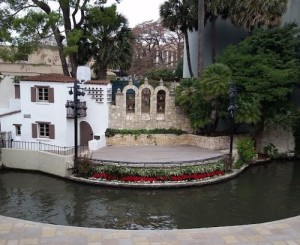Finally, we get to Cincinnati. Cincinnati is not a perfect city by any stretch of the imagination. It’s in the “rust belt,” which (for those not in the United States) is a reference to the region that used to rely heavily upon industrial jobs but where the industrial jobs have disappeared, sending the economy and population of the region into something of a tailspin. Cincinnati also has, from what I have read, a great deal of racial tension. Chicago is not free of racial tension, but I grew up in an area that had had been dragged kicking and screaming into racial diversity and now I live in San Antonio, which is more diverse than not (the 2010 census reports that the population of white non-Latino residents in the city proper is 26.6%).
So, Cincinnati is not exactly heaven on Earth or anything like that (despite being the place where a family friend had a conversion experience). What Cincinnati has that makes it worth the trip? Is Cincinnati Union Terminal (now home to the Cincinnati Museum Center).
I have actually been to Cincinnati twice. The first time was in 1980, when Union Terminal was a shopping mall. My mom and I visited the mall while my dad was working and we had a wonderful time. The mall was, well, a mall. But the building? Is beautiful. The rotunda, the tiny details. Even the pay phones were gorgeous. This was, of course, back in the days before everyone had a cell phone and we had to call my dad to arrange where he was going to pick us up, so we had to find a pay phone and the phone booths were very Art Deco. I half-expected Superman to emerge from one.
Speaking of Superman, Cincinnati Union Terminal is also the inspiration for the Hall of Justice from the old 1970s Super Friends cartoon show. So if train stations aren’t your thing, and neither is Art Deco architecture or museums, perhaps it would be worth the visit for the comics/Saturday-morning-cartoon fan in your traveling group.
When my folks and I returned to Cincinnati in 1987, Union Terminal sat empty. This was distressing for both my mom and me, since it’s such a lovely building and we’d had such a good time there. Little did we know (since the Internet wasn’t widely available yet) that plans were under way to turn Union Terminal into the Cincinnati Museum Center.
I only discovered this information around three or four years ago, when a friend was planning a trip to Cincinnati and asked what there was to do there. I was sad that the station had been empty and looked it up, dreading to find that the building was razed. Lo and behold, the building had been given new life. Since 1990, the Museum Center has been home to the Cincinnati History Museum, the Duke Energy Children’s Museum, the Museum of Natural History and Science, and an Omnimax theater.
Of course, I have not returned to Cincinnati since the opening of the Museum Center, but I am planning another trip to Cincinnati in 2017. My hope is that when Alex and I go to Kentucky for the eclipse we will drive there (stopping in Nashville to see the Parthenon on the way). Perhaps we will visit Graceland as well; I don’t know what kind of time we’ll have available. But Hopkinsville, Kentucky, the town closest to the point of greatest eclipse, is only four hours from Cincinnati. I’ve been in Texas for nearly 23 years now. A four-hour drive really is “only” to me. So I figure that we’ll start a day earlier, overshoot Hopkinsville by four hours, visit Union Terminal (and take lots of pictures!), spend the night in Cincinnati or in Louisville, and then get up extra early to make it back to Hopkinsville in time for the eclipse. At least, that’s the plan. Let’s see how it works out in practice.

